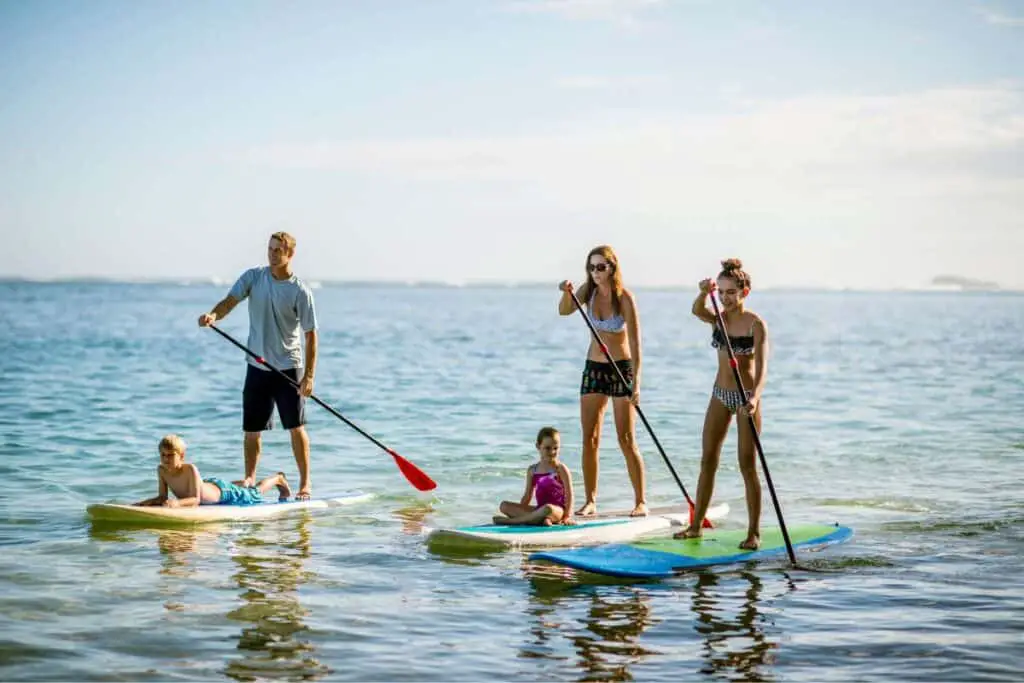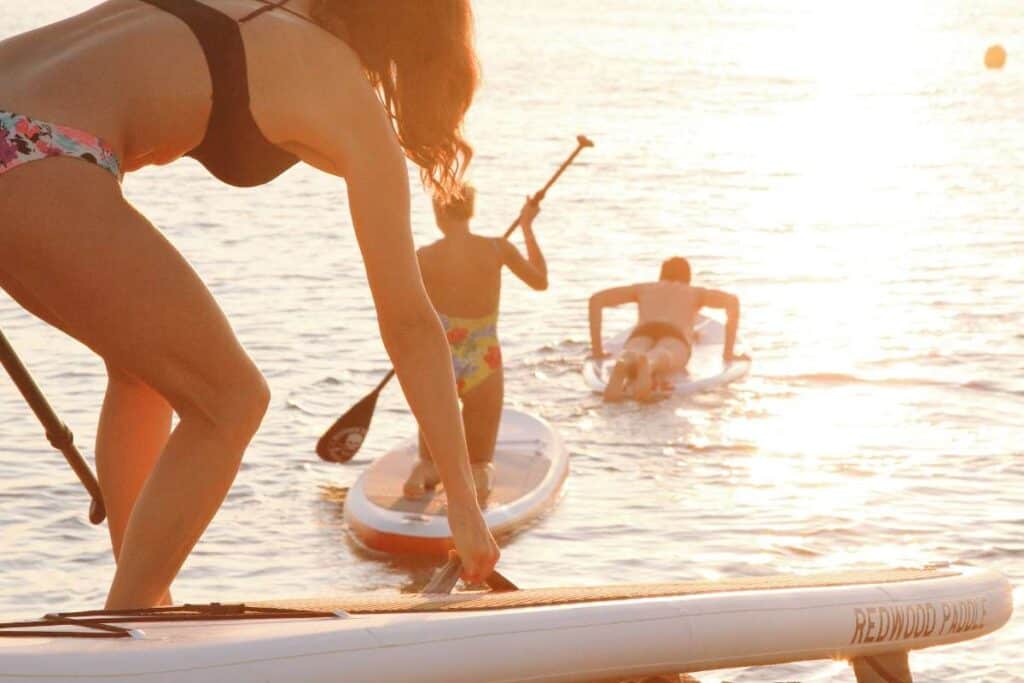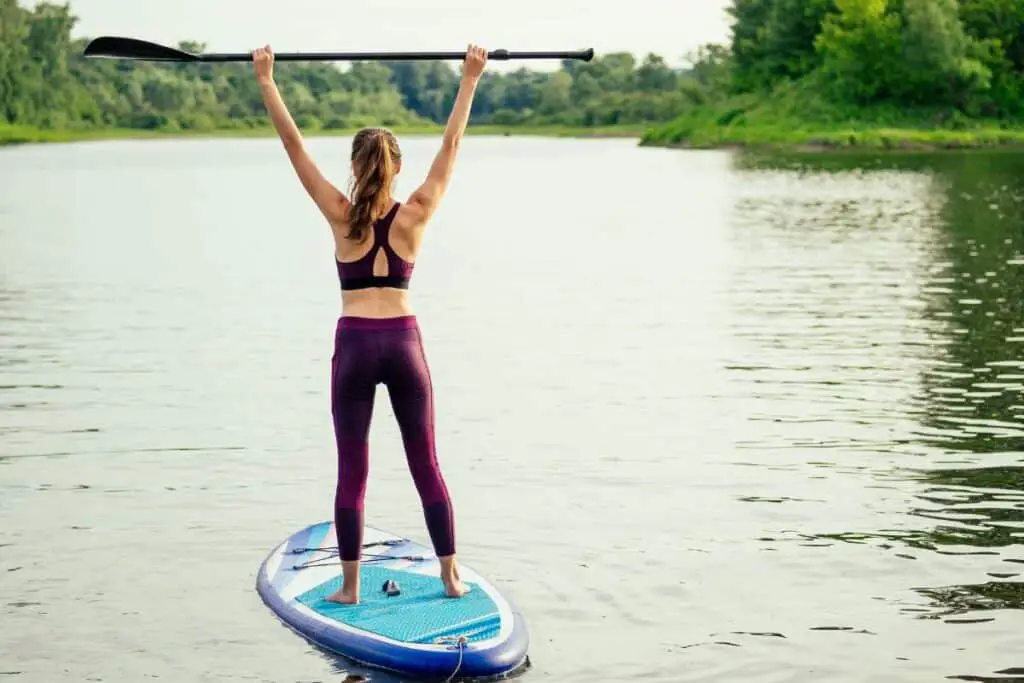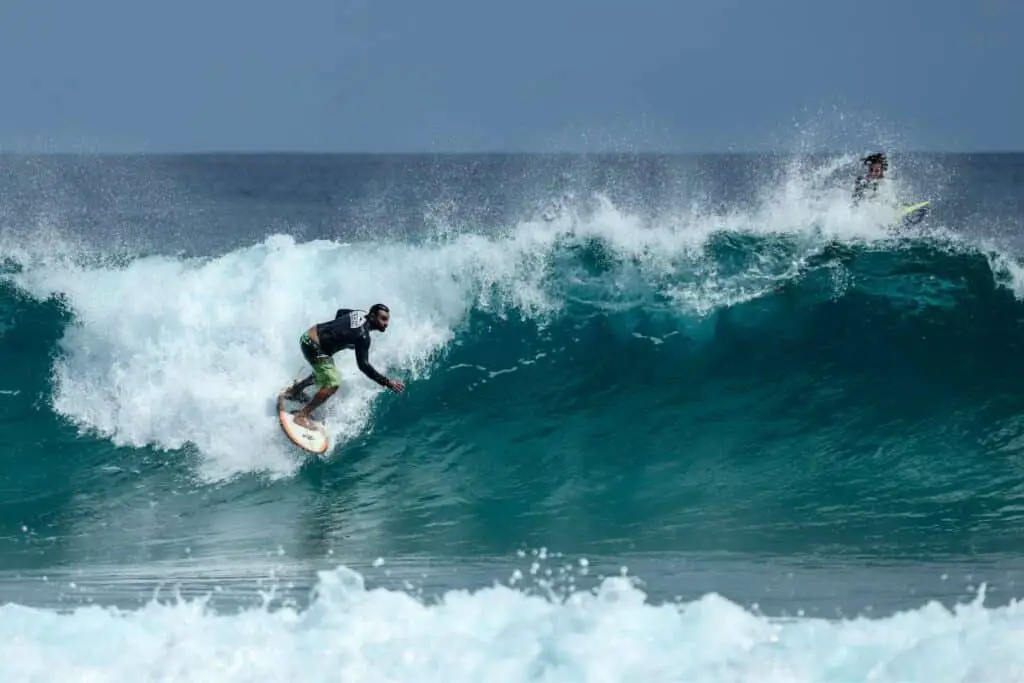Stand up paddleboarding (SUP) and traditional surfing are both popular water sports that offer thrill and excitement to their enthusiasts.
However, for those just starting out, determining which of these activities is easier can be a conundrum. The learning curve, equipment, and skill set required for each sport can influence the decision of beginners looking to get their feet wet, figuratively and literally.

SUP surfing involves standing on a larger, more buoyant board and using a paddle to navigate and catch waves, while traditional surfing requires the rider to paddle with their arms and maintain balance on a smaller board.
Many surfers agree that SUP surfing is generally easier to learn, as it often allows for quicker progress in standing up and riding waves compared to traditional surfing.
However, it is essential to acknowledge that both sports present their own distinct challenges and benefits, and the level of difficulty varies depending on conditions such as wave size and location.
Ultimately, the choice between SUP surfing and traditional surfing comes down to personal preference and individual abilities, with each offering its own unique experiences and rewards.
Sup Surfing Vs. Traditional Surfing

Key Differences
- Equipment: In SUP (stand-up paddleboarding) surfing, a paddle is used to navigate and catch waves, whereas traditional surfing solely relies on the surfer’s arm strength and body movements. SUP surfers typically have larger, more stable boards compared to traditional surfboards.
- Learning curve: Most surfers agree that SUP surfing has a tamer learning curve than traditional surfing. It is generally easier for beginners to stand and ride waves on a SUP board than on a surfboard.
- Core strength and balance: Traditional surfing requires a greater degree of core strength and balance, as surfers have to pop up on the board and maintain stability solely through their body movements. SUP surfing, on the other hand, allows individuals to benefit from the added stability provided by the paddle.
- Fitness levels: While both SUP and traditional surfing provide a good workout, SUP surfing engages more upper body muscles due to the use of a paddle.
Similarities
Wave riding: Despite the differences in equipment and approach, both SUP and traditional surfing involve the fundamental goal of catching and riding waves.
Technique: Whether one opts for SUP or traditional surfing, proper technique is crucial for success, including positioning on the board, timing, and reading waves.
Environment: Both SUP surfers and traditional surfers share the same ocean playground, which means they need to be mindful of water conditions, other surfers, and marine life.
Overall, SUP surfing may be easier to learn for beginners, but both sports present their own unique challenges.
Personal preference and goals ultimately determine which of these two exhilarating water sports might be the right choice for an individual.
Equipment and Gear

SUP Surfing Essentials
When it comes to SUP surfing, there is a variety of equipment necessary for a smooth and enjoyable experience.
One of the most important pieces of gear is the board. SUP boards are typically larger than traditional surfboards, in terms of length, width and volume.
This increases the board’s buoyancy, making it easier to balance on the water. There are also inflatable SUP boards, which offer convenience for storage and transportation.
Another essential element of SUP surfing is the paddle. Paddles are used to propel and maneuver the board, and they usually have smaller blades than touring paddles.
When choosing a paddle for SUP surfing, it should roughly match the rider’s height, but personal preference and board size should also be considered.
Other key equipment for SUP surfing includes:
- Wetsuits: To provide thermal protection in cold water
- Gloves: For added grip and warmth
- Fins: To aid maneuverability and tracking
- Leash: To keep the board attached to the rider in case of a fall
- PSI (Pounds per Square Inch): In the case of inflatable boards, it’s important to know the recommended PSI for proper inflation
Traditional Surfing Essentials
For traditional surfing, the primary component is the surfboard.
There are various types of surfboards, including shortboards, longboards, and more specialized styles.
The size, design, and shape of the board will depend on the rider’s skill level, the type of waves they plan to surf, and their personal preferences. Specific features of the surfboard include the nose, tail, and volume, which can affect the board’s performance characteristics.
Fins are also crucial in the traditional surf setup, as they help surfers maintain control. Various fin systems can be used to influence the performance of the surfboard, from single fins to tri-fin setups.
Additionally, traditional surfers typically use:
- Wetsuits: For insulation in cold water conditions
- Leash: To keep the surfboard attached when falling off
- Wax: Applied to the top deck of the surfboard to provide grip
In summary, both SUP surfing and traditional surfing require specific equipment tailored to the needs of each sport.
SUP surfing involves larger boards and paddles, while traditional surfing involves a diverse range of surfboards. Both sports utilize wetsuits, leashes, and fins as essential equipment.
Learning and Skills

Sup Surfing Skills
SUP surfing requires a different skill set compared to traditional surfing.
SUP surfers use a paddle to propel themselves onto a wave, which involves learning proper paddle techniques. Paddleboarding requires a strong core and good balance, but the larger board size and added stability from the paddle make it easier for beginners to learn.
In SUP surfing, the surfer starts by standing in a parallel stance, feet shoulder-width apart. This position allows the rider to maintain stability while using the paddle to maneuver the board.
As the surfer gains experience, they can begin to perform more advanced moves like pivot turns and bottom turns.
Some key skills and considerations for SUP surfing include:
- Balance: Good balance is essential for staying upright on a larger, more stable board.
- Board size: Most beginner SUP surfers start with a board that’s 10-11 feet long and 30+ inches wide for added stability.
- Technique: Proper paddle technique is crucial for efficient propulsion and maneuverability.
- Fitness level: A decent fitness level is beneficial for maintaining stability and controlling the board.
Traditional Surfing Skills
Traditional surfing, on the other hand, features a diverse range of skills and techniques to be learned.
Surfers must develop their balance and timing to catch waves on a smaller, less stable board. Board choice is also essential, with options ranging from shortboards to longboards and foam surfboards for beginners.
Traditional surfers often start by lying on the surfboard in a prone position, paddling with their arms while positioning their feet near the tail of the board.
Once in position to catch a wave, surfers must quickly pop up into the correct stance to ride the wave.
Skills and considerations for traditional surfing include:
- Balance: A strong sense of balance is vital for maintaining control on a smaller, more agile surfboard.
- Board choice: A foam surfboard or a longboard can provide more stability for beginners.
- Paddling technique: Efficient paddling is crucial for catching waves and positioning.
- Duck diving: This skill allows surfers to dive under oncoming waves while holding onto their board, which is necessary for getting out past the break.
- Etiquette: Proper surf etiquette is important to maintain safety and respect among fellow surfers in the lineup.
In summary, both SUP surfing and traditional surfing have unique skill sets to learn, but SUP surfing is generally considered easier for beginners due to the larger board and additional stability provided by the paddle. However, both activities require balance, technique, and practice to excel.

